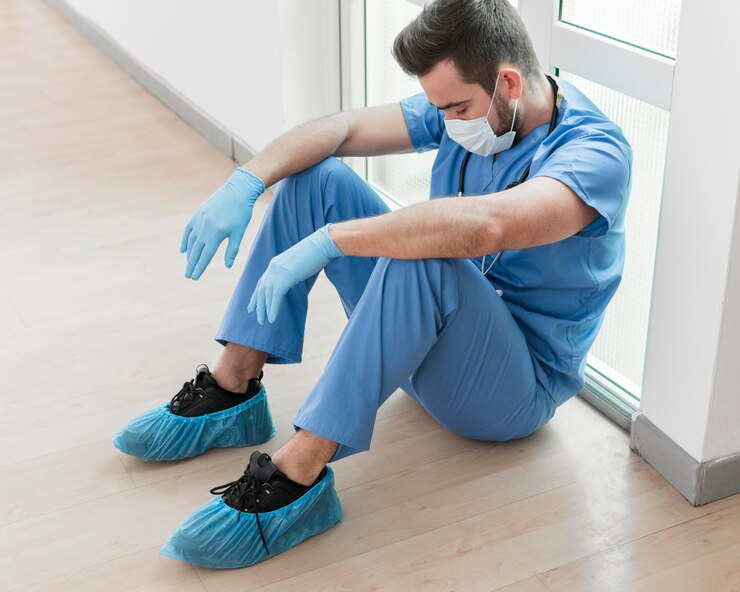The dedication of nurses and doctors is unwavering. Long shifts on their feet, demanding workloads, and steadfast commitment to patient care define their profession. However, these demanding schedules also come with physical challenges. Leg fatigue, swelling, and even the risk of Deep Vein Thrombosis (DVT) are common concerns for healthcare professionals. This blog explores how compression socks can be a valuable tool for nurses and doctors, offering potential benefits for:
- Reducing Leg Fatigue and Swelling: Long periods of standing can wear down the legs, leading to fatigue and swelling. Compression socks may provide relief.
- Preventing DVT: DVT is a serious blood clot that can form in the deep veins of the legs. Compression socks may play a role in DVT prevention.
- Enhancing Comfort and Support Throughout the Day: Compression socks can offer extra support and comfort for nurses and doctors during their long shifts.
The Challenge of Long Shifts: Leg Fatigue and Swelling
Nurses and doctors often spend extended periods standing in place, leading to several challenges:
- Venous Insufficiency: Gravity naturally pulls blood downwards. Standing for long periods can weaken the pumping action of leg muscles, leading to blood pooling in the veins (venous insufficiency).
- Leg Discomfort and Fatigue: Venous insufficiency contributes to leg fatigue, aching, and a heavy feeling in the legs.
- Swelling: Fluid can leak from the veins into surrounding tissues, causing swelling in the ankles and legs.
These symptoms can significantly impact a healthcare professional’s comfort and performance during long shifts.
Compression Socks: A Potential Ally for Reduced Fatigue and Swelling
Compression socks apply graduated pressure, which is highest at the ankle and gradually decreases towards the calf. This pressure offers several potential benefits for nurses and doctors:
- Improved Venous Return: Compression can promote blood flow back to the heart, potentially reducing blood pooling and minimising venous insufficiency.
- Reduced Leg Discomfort: Improved blood flow may lead to less leg fatigue, aching, and a feeling of heaviness in the legs.
- Minimized Swelling: Compression socks may help minimise fluid accumulation in the tissues by reducing blood pooling, leading to less leg swelling.
While individual experiences may vary, the potential for reduced leg fatigue and swelling makes compression socks attractive for nurses and doctors.
Preventing DVT: A Critical Consideration for Healthcare Professionals
DVT is a serious blood clot that can form in the deep veins of the legs. Symptoms may include leg pain, swelling, and redness. If left untreated, a blood clot can break off and travel to the lungs (pulmonary embolism), potentially leading to life-threatening complications.
Nurses and doctors are at increased risk of DVT due to prolonged periods of immobility and other factors.
Compression Socks and Potential DVT Prevention
Compression socks may play a role in DVT prevention for nurses and doctors:
- Reduced Venous Insufficiency: Compression socks may lower the risk of clot formation by improving blood flow and minimising blood pooling.
- Improved Blood Flow Velocity: Compression can increase blood flow velocity, reducing the chances of blood clotting.
It’s important to note that compression socks are not a standalone solution for DVT prevention. Consulting a healthcare professional for preventative measures is crucial. However, compression socks for nurse, combined with other strategies like regular movement breaks and staying hydrated, can help reduce the risk of DVT.
Beyond Functionality: Enhancing Comfort and Support for Long Shifts
Comfort matters when facing demanding schedules. Compression socks canada can offer additional benefits for nurses and doctors:
- Improved Proprioception: Compression may enhance proprioception, the body’s awareness of its position in space. This can lead to better balance and potentially reduce fatigue.
- Reduced Muscle Vibration: Muscle vibration can contribute to fatigue during long shifts. Compression socks may minimise muscle vibration, potentially improving comfort.
- Warmth Retention: Some compression socks are made from materials that retain warmth, improving comfort in colder environments.
Compression socks can be valuable for nurses and doctors who seek improved comfort, support, and well-being during their long shifts.
Conclusion: Empowering Healthcare Professionals with CompressionSocks.ca
At CompressionSocks.ca, we understand the unique challenges nurses and doctors face. We aim to empower you with the tools to enhance your well-being and performance.
Here’s how we can support you:
- High-Quality Support Hose Canada: We offer a curated selection of compression socks designed for healthcare professionals, ensuring comfort and support during long shifts.
- Expert Guidance: Our team can help you choose the right compression socks based on your needs, work environment, and specific concerns.
- Unwavering Customer Support: Our dedicated customer service team is here to answer your questions and provide personalised recommendations.
Embrace a More Fulfilling Career with CompressionSocks.ca
Whether you’re a nurse, doctor, or other healthcare professional, compression socks can be a valuable tool for reducing leg fatigue and swelling and supporting your overall well-being. Explore our extensive collection and discover the difference compression socks can make in your career.
Take the First Step Towards a More Comfortable and Fulfilled Career
Visit CompressionSocks.ca today and explore our curated selection of compression socks for healthcare professionals. Experience the benefits of improved circulation, reduced fatigue, and enhanced comfort. With CompressionSocks.ca, you’re taking a step towards a brighter, more fulfilling career.







